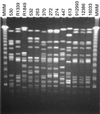Animal and human multidrug-resistant, cephalosporin-resistant salmonella isolates expressing a plasmid-mediated CMY-2 AmpC beta-lactamase
- PMID: 10991860
- PMCID: PMC90151
- DOI: 10.1128/AAC.44.10.2777-2783.2000
Animal and human multidrug-resistant, cephalosporin-resistant salmonella isolates expressing a plasmid-mediated CMY-2 AmpC beta-lactamase
Abstract
Salmonella spp. are important food-borne pathogens that are demonstrating increasing antimicrobial resistance rates in isolates obtained from food animals and humans. In this study, 10 multidrug-resistant, cephalosporin-resistant Salmonella isolates from bovine, porcine, and human sources from a single geographic region were identified. All isolates demonstrated resistance to cephamycins and extended-spectrum cephalosporins as well as tetracycline, chloramphenicol, streptomycin, and sulfisoxazole. Molecular epidemiological analyses revealed eight distinct chromosomal DNA patterns, suggesting that clonal spread could not entirely explain the distribution of this antimicrobial resistance phenotype. However, all isolates encoded an AmpC-like beta-lactamase, CMY-2. Eight isolates contained a large nonconjugative plasmid that could transform Escherichia coli. Transformants coexpressed cephalosporin, tetracycline, chloramphenicol, streptomycin, and sulfisoxazole resistances. Plasmid DNA revealed highly related restriction fragments though plasmids appeared to have undergone some evolution over time. Multidrug-resistant, cephalosporin-resistant Salmonella spp. present significant therapeutic problems in animal and human health care and raise further questions about the association between antimicrobial resistance, antibiotic use in animals, and transfer of multidrug-resistant Salmonella spp. between animals and man.
Figures


References
-
- Arbeit R D. Laboratory procedures for the epidemiologic analysis of microorganisms. In: Murray P R, Baron E J, Pfaller M A, Tenover F C, Yolken R H, editors. Manual of clinical microbiology. Washington, D.C.: American Society for Microbiology; 1995. pp. 190–208.
-
- Ausubel F M, Brent R, Kingston R E, Moore D D, Seidman J G, Smith J A, Stzuhl K. Current protocols in molecular biology. New York, N.Y: John Wiley and Sons, Inc.; 1993.
Publication types
MeSH terms
Substances
LinkOut - more resources
Full Text Sources
Other Literature Sources
Medical
Miscellaneous

